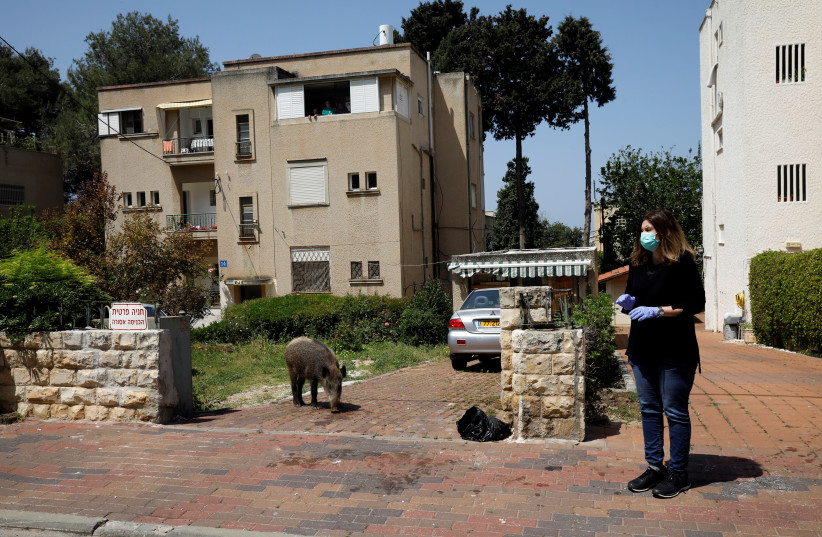Haifa and its environs have been beset in recent years by large numbers of wild pigs (Sus scrofa) running through neighborhoods, scaring children and the elderly and overturning garbage bins. While some Haifa residents like them and feed them, some have suggested killing them, but this method of doing away with them has not been approved by the Agriculture Ministry or municipality.
Haifa is not the only place plagued by wild pigs. It has also occurred in the southeastern part of the US – but officials there have found an answer. The University of Georgia’s Savannah River Ecology Laboratory and Warnell School of Forestry and Natural Resources have spent the last two years trying to control the fearsome mammals. The researchers at the Savannah River Site in Aiken, South Carolina, reduced by 70% the number of pigs and brought about a decline in environmental rooting damage of about 99%.
They published their findings in the journal Pest Management Science under the title “Changes in wild pig (Sus scrofa) relative abundance, crop damage, and environmental impacts in response to control efforts.”
Pigs imported and exported globally
Native to Eurasia, the pigs were introduced worldwide for food and hunting opportunities, and over the last several decades have become one of the world's most troublesome invasive species. Pigs were introduced to the US centuries ago as a food source and quickly established wild populations.

Feral domestic pigs bred with purebred Eurasian boar that were introduced for hunting, and hybridized wild pigs spread across the landscape due to prolific reproductive rates and a willingness to eat just about anything. Wild pigs are omnivorous, have high reproductive rates and are rarely eaten by other wild animals, even when young. Populations exploded in the late 1980s and early 1990s, causing a substantial increase in damages to agricultural producers. In response, many large-scale control programs were put in place to reduce populations across the landscape, usually through lethal methods.
Is hunting the solution?
Due to the substantive damage caused by wild pigs, efforts are often made to control populations, and in many US states, recreational hunting is popular and assumed to help control populations, but there is little evidence supporting the effectiveness of recreational hunting as a long-term management tool for controlling the spread of wild pigs, they wrote. Iin many cases, sport hunting may be counterproductive to population control objectives – it typically removes about a quarter of a population, which is, on average, far below thresholds believed to be needed to reduce their numbers.
The study will help conservation groups understand and plan for managing a problem with both environmental and economic costs, as wild pigs were responsible for over $1.5 billion in property and crop damage in just one year, they said.
“Through their destructive foraging habits, wild pigs cause extensive damages to crops across the country,” said wildlife ecology and management Prof. Jim Beasley. “Wild pigs also carry several diseases that can be transferred to livestock, adding to their substantial agricultural impact.”
When pigs forage, they upturn roots and soil with their snouts, damaging natural habitats and other animals. As natural omnivores, pigs also eat amphibians and other small creatures, potentially impacting their populations over time.
In this study, Beasley and his team investigated whether such programs succeeded and, if so, whether environmental damages were reduced as well. They worked with 19 mixed-forest agricultural properties in South Carolina, surveying the pig populations and agricultural and environmental damages, following the implementation of a professional control program over a three-year period.
“Before the trappers went in and began management efforts, we placed remote cameras baited with corn around the properties to assess the initial population of wild pigs. Every six months, we would go back out and reassess the populations to see how effective the management methods were,” Beasley said.
“Most studies estimate that you need to remove 40% to 60% of a wild- pig population each year to maintain or significantly reduce a population, and they exceeded that threshold,” Beasley said. “With sustained management the population should continue to shrink over the next several years. However, what is unknown is how quickly the population will recover if management efforts cease.”
While trapping was the main method of wild-pig removal, ground- and night-shooting events also took place where applicable. Aerial gunning by helicopter was also used on one property that had large enough open areas.
Beasley attributes the population explosion to several factors, including humans illegally moving wild pigs to the areas where hunting them is legal year-round, as well as to warmer climates in recent decades. “It’s really a combination of both human-driven factors and natural expansions of populations,” Beasley said.
